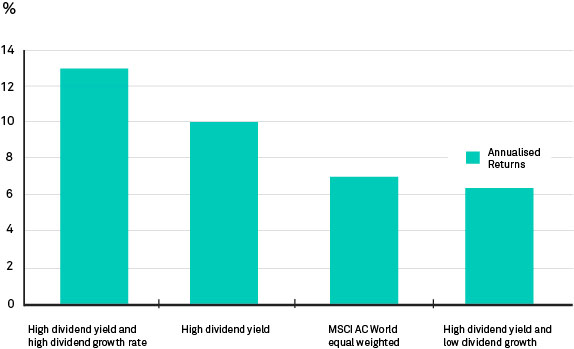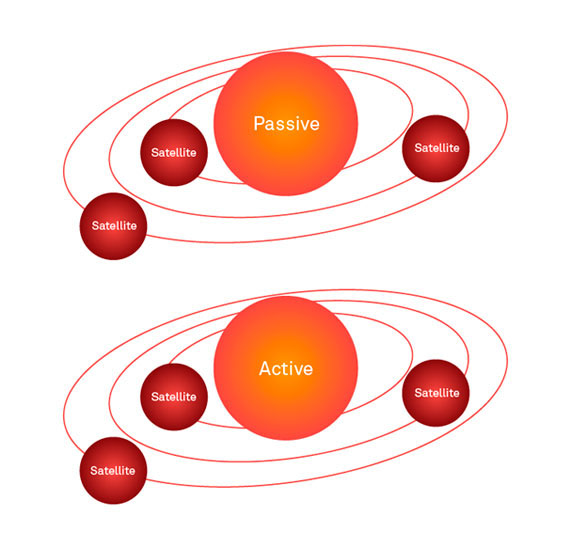 It's a changing Financial World
It's a changing Financial World
Yields are low. Markets are volatile. Confidence is scarce. The investment world looks daunting, opportunities seem thin on the ground and some long-relied upon investment approaches may no longer work. There is one question on everyone's mind:
"What to do with your money?"
The good news is there are opportunities out there. We believe your portfolio today must be flexible enough to adapt to rapidly changing markets – and more diverse than it's ever been before. This may mean investing in a broader array of investments and diversifying both across geographies and asset classes and within them. A More Dynamic, Diverse Portfolio.
Below are five useful actions to discuss with your financial adviser:
1. Rethink the Cost of Cash
While holding cash protects capital, in the long run, low interest rates leave the value of money susceptible to inflation, reducing purchasing power in years to come. In today's uncertain markets, many investors have switched into what they view as a riskless trade - cash. In so far as banks and building societies can be considered safe, cash deposits protect your capital and offer more predictable returns.
But even with low inflation, returns on cash have not always kept up with the cost of living. While holding some cash is wise, it may not be the right way to save in the long run, given our low interest rate environment and the erosive effects of inflation.
Assuming a 3% inflation rate, £100,000 in cash would be worth the equivalent of £47,761 in 25 years' time in terms of purchasing power if we ignore the effects of interest income.
What to do with your money?
A traditional safe haven, cash protects your capital, but over the long run it may not meet your goals, especially when interest rates are below inflation. While today's market conditions understandably produce anxiety, investors with large amounts of cash should take a step back, reassess their goals and risk tolerance and work with their financial advisers to make their money work harder.
Erosion of Purchasing Power
Impact of Hypothetical 3% Annual Inflation Rate (assuming no interest return for simplicity) on the Real Value of Cash.

2. Go Further for Income
If traditional fixed income products fail to keep up with inflation, investors may consider taking on more risk and choosing assets such as company dividends and corporate bonds.
The hunt for reliable investment income has rarely been more challenging. In many countries, low interest rates means leaving money in the bank offers negligible returns. Meanwhile, yields on traditional fixed income investments such as US treasuries, UK gilts and German bonds are at all time lows. Investors are left to wonder where to find income streams that stay ahead of inflation while remaining comfortable with the risk they take on. While inflation erodes the purchasing power of cash and most traditional bonds, equity dividend growth has historically kept pace with inflation.
"What to do with your money?"
The good news is that there are sustainable and even rising income streams out there, for those who know where to look and have the risk appetite to act. It may mean embracing a different asset class or even considering new opportunities in familiar places.
The Case for Dividends
Company shares which pay dividends are an attractive income option. At the moment the yield (through dividend payments) on many shares is more than twice that on traditional government bonds. Furthermore, unlike the fixed payments on many bonds, dividends can increase over time – and in fact have historically done so at a rate that keeps up with inflation, providing real (inflation adjusted) income - see chart below. Alongside this, scope for the share price to rise offers potential for long-term capital growth. Of course there are no guarantees that equity income investment will provide an effective hedge against inflation in the future and your capital and income is at risk.
Look to Corporate Debt
For investors prepared to take on more risk, many corporate bonds offer attractive income opportunities today. Of course corporate bonds offer higher yields than US Treasuries, as they have a higher chance of default (not paying back the money they owe). However, for those who do their homework and identify strong balance sheets and robust business models, there are compelling investment stories behind some of these bonds. Company balance sheets have rarely been stronger than they are today and, with bank lending hampered, companies are increasingly turning to bond markets to raise capital.
Global High Dividend Yield and High Dividend Growth Shares Have Outperformed the Rest of the Stock Market
Annualised average % total returns from 1988 to 2011 of shares in the MSCI AC World Index in sterling terms.

Past performance is not a guide to future performance and should not be the sole factor of consideration when selecting an investment.
3. Open Your Eyes to Alternatives
Many asset classes and investing techniques historically considered the preserve of institutional investors are now more widely available. These carry their own risks, but tend to generate different returns to traditional investments, helping diversify portfolios.
The age-old adage "don't put all your eggs in one basket", is often a good rule of thumb when constructing your investment portfolio. Investing in the broadest set of opportunities as possible – across markets, asset classes and styles – often helps to smooth returns, thereby reducing risk. We believe that creating a dynamic portfolio, one that is more diverse than ever before, is an essential step to helping investors mitigate against potential future losses. An allocation to these additional diversifiers, such as alternative investments, is one way to achieve this goal.
The size of the Absolute Return UCITS Fund industry in Europe has almost quadrupled in under three years, growing from $22bn of assets under management in January 2009 to $84bn in September 2011.*
*Source: Morgan Stanley as at 30 September 2011
"What to do with your money?"
Investments that offer superior diversification – such as property, commodities or absolute return strategies – are no longer the preserve of the most sophisticated investors. Carefully blending a variety of these investments to a traditional portfolio has the potential to enhance returns while also reducing risk because they don't typically move in chorus with the other components of a portfolio. These are also more accessible than ever through unit trusts and exchange traded funds (ETFs).
4. Be Active About Passive
Exchange traded funds (ETFs) and traditional index tracker funds provide a transparent and low-cost way to tap into market returns and gain access to asset classes and global markets.
Financial experts have long debated whether investors should be either active or passive. The answer is not active or passive: it's both. Investors can combine both types of investments to create diversified portfolios. Passive investing is a low cost and efficient way to gain exposure to global markets and sectors. Active investing has scope to outperform the returns of a market through fund managers' skill. Both have their own merits and your financial adviser can help you decide the right balance between them for your portfolio.
Increasingly investors are blending active and passive funds, combining the merits of both approaches while helping to manage risk and cost.
"What to do with your money?"
Passive investments can take the form of traditional index tracking funds and exchange traded funds (ETFs). Index tracking funds aim to mirror the performance of an index, such as the FTSE 100 Index of leading UK blue-chip shares. They offer investors low cost, efficient market exposure. Like traditional funds, they price on a daily basis. ETFs are also managed to accurately mirror the performance of an index, such as the FTSE 100 Index of leading UK blue-chip shares.
They are collective investments, but can be bought and sold on a stock exchange, like a share in a company, allowing investors to adjust their portfolios nimbly and efficiently as markets shift. ETFs are often used as a flexible cost-efficient way to invest and increase access to markets that can be difficult or expensive to enter such as alternatives and emerging markets.
Core/satellite investing
Core/satellite investing is based on the simple concept of splitting a portfolio into two segments. Passive funds are sometimes used as a core part of an investor's portfolio and sometimes as satellites. Satellite investments are typically used for exposure to more specialised asset classes and markets. Investors can work with their financial advisers to determine the appropriate balance for their portfolio.
See image below:

5. Use Your Longevity
We are living longer. This allows investors to expand their investment horizon well beyond the day they retire and perhaps keep some carefully tailored exposure to risk assets such as equities for longer than they may have in the past.
As life spans increase, many investors worry they will outlive their savings. With longer retirements than ever before, they may need to rethink their pension ideas. Retirement used to be a single life-stage. However, it makes more sense now to think about retirement as having several phases, each with slightly different financial needs. Investors can now expand their investment time horizons well beyond the date they retire and generate long-term returns to retain the lifestyle they want.
A healthy couple aged 65 in the United States now has a 50% chance that at least one of them will live to the age of 92, and a 25% chance that one of them will reach 97.
Source: Annuity 2000 Mortality table, Society of Actuaries, US. Figures assume you are in good health.
"What to do with your money?"
Living well in older age is about building smart, dynamic, diverse and global portfolios. It is about investing across more asset classes for specific needs or "outcomes", "fulfilling a long held dream" or simply achieving the kind of retirement you want. Investors should consider maintaining some carefully tailored exposure to risk assets, such as company shares, for longer than retirees have done in the past. Investors of all ages should consider ways to keep their money working harder to help them achieve their goals.
 Use TheMoneyLabel™ , our free service to look across asset classes and see what exactly you are invested in.
Use TheMoneyLabel™ , our free service to look across asset classes and see what exactly you are invested in.
Independent financial advice should always be attained in order to assess your own individual circumstance. If you require financial advice please contact us to arrange an appointment. The value of your investetment can go down as well as up and you may get back less than than the amount invested. Past perfomance is not a guide to future performance.